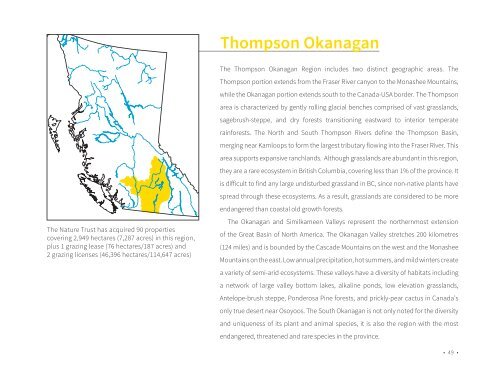Nature Trust of BC Photo Book Excerpt
This is an excerpt from our 47 Years of Conservation photo book.
This is an excerpt from our 47 Years of Conservation photo book.
Create successful ePaper yourself
Turn your PDF publications into a flip-book with our unique Google optimized e-Paper software.
Thompson Okanagan<br />
The Thompson Okanagan Region includes two distinct geographic areas. The<br />
Thompson portion extends from the Fraser River canyon to the Monashee Mountains,<br />
while the Okanagan portion extends south to the Canada-USA border. The Thompson<br />
area is characterized by gently rolling glacial benches comprised <strong>of</strong> vast grasslands,<br />
sagebrush-steppe, and dry forests transitioning eastward to interior temperate<br />
rainforests. The North and South Thompson Rivers define the Thompson Basin,<br />
merging near Kamloops to form the largest tributary flowing into the Fraser River. This<br />
area supports expansive ranchlands. Although grasslands are abundant in this region,<br />
they are a rare ecosystem in British Columbia, covering less than 1% <strong>of</strong> the province. It<br />
is difficult to find any large undisturbed grassland in <strong>BC</strong>, since non-native plants have<br />
spread through these ecosystems. As a result, grasslands are considered to be more<br />
endangered than coastal old growth forests.<br />
The <strong>Nature</strong> <strong>Trust</strong> has acquired 90 properties<br />
covering 2,949 hectares (7,287 acres) in this region,<br />
plus 1 grazing lease (76 hectares/187 acres) and<br />
2 grazing licenses (46,396 hectares/114,647 acres)<br />
The Okanagan and Similkameen Valleys represent the northernmost extension<br />
<strong>of</strong> the Great Basin <strong>of</strong> North America. The Okanagan Valley stretches 200 kilometres<br />
(124 miles) and is bounded by the Cascade Mountains on the west and the Monashee<br />
Mountains on the east. Low annual precipitation, hot summers, and mild winters create<br />
a variety <strong>of</strong> semi-arid ecosystems. These valleys have a diversity <strong>of</strong> habitats including<br />
a network <strong>of</strong> large valley bottom lakes, alkaline ponds, low elevation grasslands,<br />
Antelope-brush steppe, Ponderosa Pine forests, and prickly-pear cactus in Canada’s<br />
only true desert near Osoyoos. The South Okanagan is not only noted for the diversity<br />
and uniqueness <strong>of</strong> its plant and animal species, it is also the region with the most<br />
endangered, threatened and rare species in the province.<br />
• 49 •




